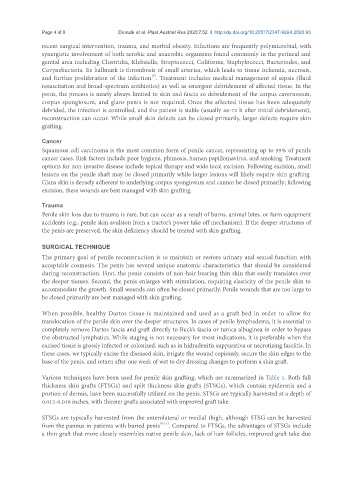Page 603 - Read Online
P. 603
Page 4 of 9 Demzik et al. Plast Aesthet Res 2020;7:52 I http://dx.doi.org/10.20517/2347-9264.2020.93
recent surgical intervention, trauma, and morbid obesity. Infections are frequently polymicrobial, with
synergistic involvement of both aerobic and anaerobic organisms found commonly in the perineal and
genital area including Clostridia, Klebsiella, Streptococci, Coliforms, Staphylococci, Bacteriodes, and
Corynebacteria. Its hallmark is thrombosis of small arteries, which leads to tissue ischemia, necrosis,
[7]
and further proliferation of the infection . Treatment includes medical management of sepsis (fluid
resuscitation and broad-spectrum antibiotics) as well as emergent debridement of affected tissue. In the
penis, the process is nearly always limited to skin and fascia so debridement of the corpus cavernosum,
corpus spongiosum, and glans penis is not required. Once the affected tissue has been adequately
debrided, the infection is controlled, and the patient is stable (usually 48-72 h after initial debridement),
reconstruction can occur. While small skin defects can be closed primarily, larger defects require skin
grafting.
Cancer
Squamous cell carcinoma is the most common form of penile cancer, representing up to 95% of penile
cancer cases. Risk factors include poor hygiene, phimosis, human papillomavirus, and smoking. Treatment
options for non-invasive disease include topical therapy and wide local excision. Following excision, small
lesions on the penile shaft may be closed primarily while larger lesions will likely require skin grafting.
Glans skin is densely adherent to underlying corpus spongiosum and cannot be closed primarily; following
excision, these wounds are best managed with skin grafting.
Trauma
Penile skin loss due to trauma is rare, but can occur as a result of burns, animal bites, or farm equipment
accidents (e.g., penile skin avulsion from a tractor’s power take off mechanism). If the deeper structures of
the penis are preserved, the skin deficiency should be treated with skin grafting.
SURGICAL TECHNIQUE
The primary goal of penile reconstruction is to maintain or restore urinary and sexual function with
acceptable cosmesis. The penis has several unique anatomic characteristics that should be considered
during reconstruction. First, the penis consists of non-hair bearing thin skin that easily translates over
the deeper tissues. Second, the penis enlarges with stimulation, requiring elasticity of the penile skin to
accommodate the growth. Small wounds can often be closed primarily. Penile wounds that are too large to
be closed primarily are best managed with skin grafting.
When possible, healthy Dartos tissue is maintained and used as a graft bed in order to allow for
translocation of the penile skin over the deeper structures. In cases of penile lymphedema, it is essential to
completely remove Dartos fascia and graft directly to Buck’s fascia or tunica albuginea in order to bypass
the obstructed lymphatics. While staging is not necessary for most indications, it is preferable when the
excised tissue is grossly infected or colonized, such as in hidradenitis suppurativa or necrotizing fasciitis. In
these cases, we typically excise the diseased skin, irrigate the wound copiously, secure the skin edges to the
base of the penis, and return after one week of wet to dry dressing changes to perform a skin graft.
Various techniques have been used for penile skin grafting, which are summarized in Table 1. Both full
thickness skin grafts (FTSGs) and split thickness skin grafts (STSGs), which contain epidermis and a
portion of dermis, have been successfully utilized on the penis. STSGs are typically harvested at a depth of
0.012-0.018 inches, with thinner grafts associated with improved graft take.
STSGs are typically harvested from the anterolateral or medial thigh, although STSG can be harvested
from the pannus in patients with buried penis [8-11] . Compared to FTSGs, the advantages of STSGs include
a thin graft that more closely resembles native penile skin, lack of hair follicles, improved graft take due

